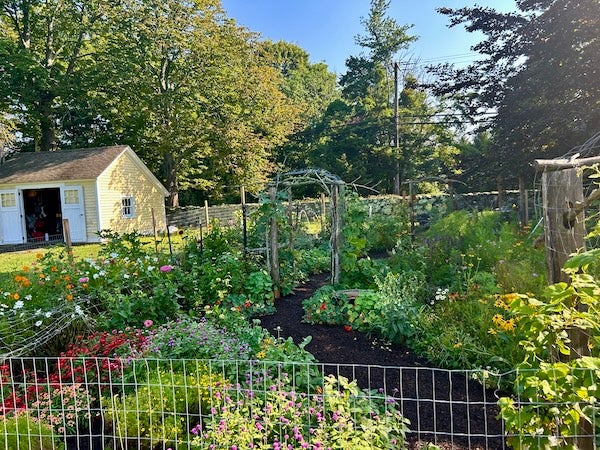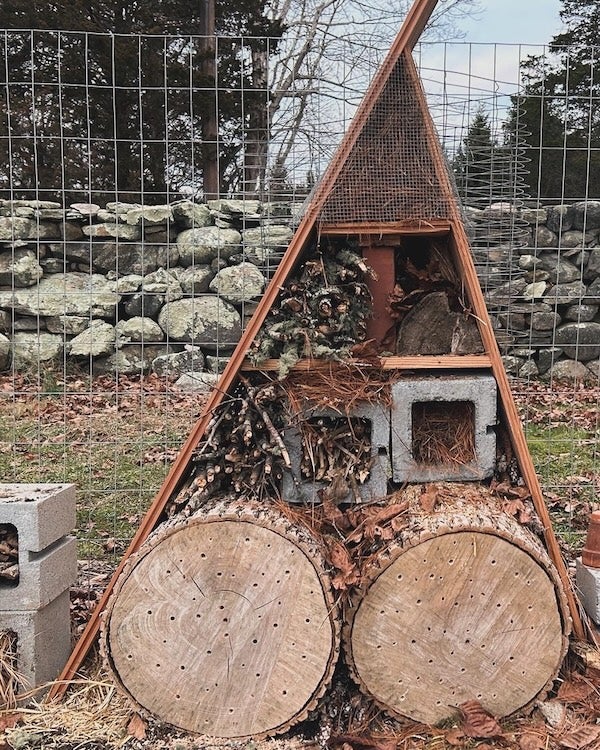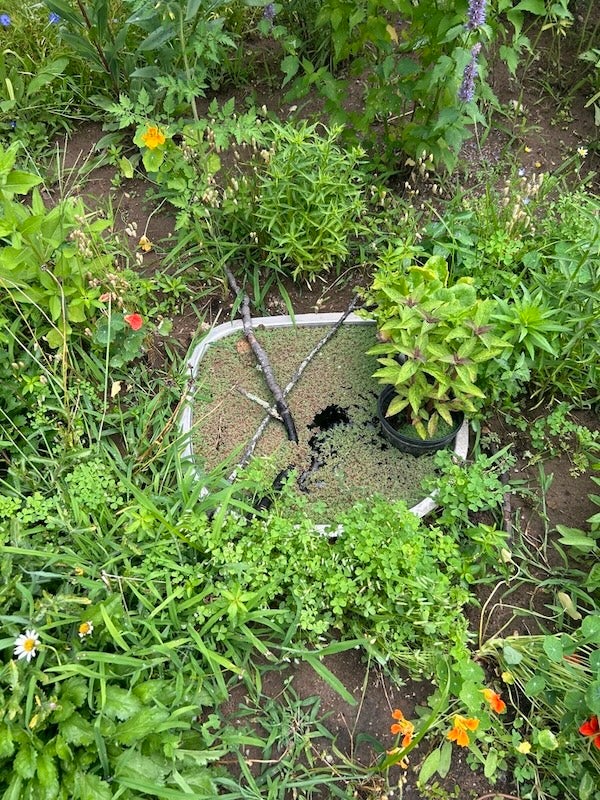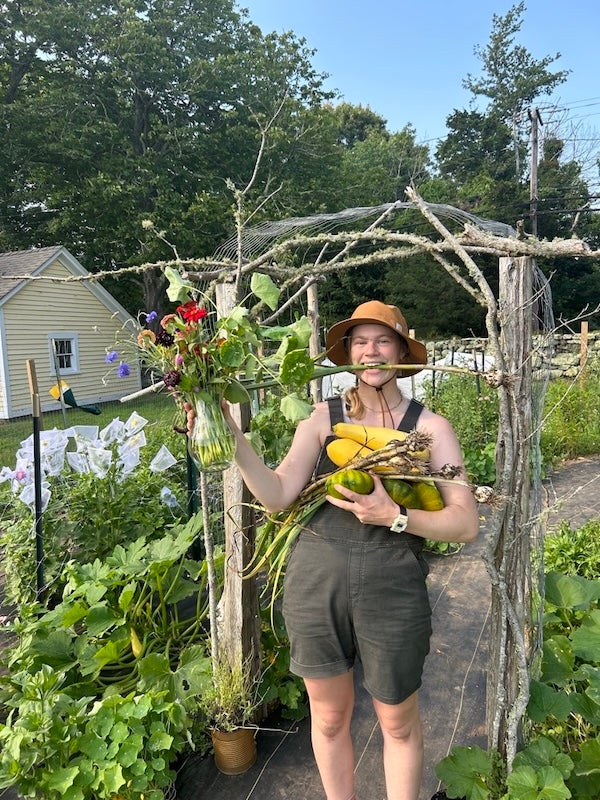Margit Burgess wants people to rethink their lawns. “Lawns are the most irrigated crop in the United States and their monocrop nature makes them a green desert–a biodiversity deadzone–for wildlife.” she says. “With rapid biodiversity decline, we need to provide for the ecosystems which provide for us.”
Among other concerns with maintaining well curated lawns, such as excessive water usage, commonly used pesticides can harm beneficial insects such as bees and ladybugs. Native plants provide necessary nourishment and habitats for native pollinators, birds, and wildlife–which are essential for a thriving environment–and come with other perks for homeowners: they are more disease resistant and typically require less maintenance and watering.
Inspired by the work of Doug Tallamy, an entomologist, ecologist, conservationist, and founder of the Homegrown National Park movement, Burgess is passionate about encouraging people to adopt biodiverse landscaping practices and prioritize native plants in their outdoor spaces. While national parks are essential to preserving native species, they are too far apart geographically to preserve biodiversity at meaningful levels.

“Prior to starting at URI, I created my own ‘Homegrown National Park,’ converting my parents’ lawn into a native perennial meadow and food garden,” Burgess says. “This garden became my favorite classroom and lab, where I could experiment with different methods of lawn conversion and see which methods were least expensive and labor intensive. It’s an insect haven and I’ve seen species here that I had never seen in my parents’ yard before.”
Currently a biological and environmental sciences master’s student, Burgess’ thesis research was conducted on Mason’s Island, a small private residential island in Mystic, CT. She interviewed homeowners about their current landscaping habits and views on barriers and motivations for shifting to practices that enrich biodiversity. “I went into my interviews thinking that people wouldn’t care too much about the topic or want to change their landscaping ways, but this proved to be completely false,” she says. “Nearly everyone was open and excited about helping promote biodiversity in their local ecosystem. Several participants ended up calling me after the interview, asking if I’d come give them advice on what to do with their yards.”
When she begins her doctorate studies, Burgess looks forward to expanding her research to include lawn conversation into both native habitat and food source. “I want to add food crops into the mix in hopes of helping to create a non-commodity food market where food is free and traded/gifted between neighbors,” she says. “Additionally, I want to do an agricultural experiment, similar to what I’ve done in my own garden, where I have different plots of grass and see how I can best convert them into a food garden and native meadow.”
Burgess’ work highlights both the importance and practicality of adopting practices that cultivate and support biodiversity–regardless of the size of your yard. Below she shares some tips:

Q. What are some main “takeaways” of your work for homeowners?
A. The lawn stems from colonialism and the turfgrass species we have here today in our backyards are not native. The lawn began as a social status symbol in the days of the aristocracy, and remains that way today. American culture is socially bound to the lawn, and it is time to change. There needs to be a cultural shift from “Wow, that person has a perfect lawn, they must really have their life together!” to “That person has a ‘perfect’ lawn, that’s too bad. I wish they’d be better ecological stewards.”
Homeowners forget that they have agency with their landscapers. Make sure you are involved in decision making and know what is going on in the bounds of your property. There will never be a market for biodiverse landscaping unless homeowners demand these practices. If you are having landscapers put in a new garden bed, request native species. Homeowners can also request that the landscaper be an Accredited Organic Land Care Professional (AOLCP), certified by the Northeast Organic Farming Association (NOFA).
It is likely that some of your neighbors want to change their landscaping practices, but are afraid of judgment from the rest of the neighborhood. Neighborhood meetings or conversations with neighbors about this go a long way. If you are worried about what your neighbors will think about new practices, you can even put up a small sign that reads something akin to “Excuse my natural appearance, tending to the insects who need us!” or “Native pollinator meadow in progress.”
What are the top three things you wish homeowners would take into consideration when planning or cultivating their home landscaping?
#1. Adopting biodiverse landscaping practices does not have to look one way, nor does it have to be labor intensive. In fact, it is often much less maintenance than a lawn, once it’s established. You do not have to rip up all of your grass and turn your lawn into a meadow in order to help your ecosystem. If you are currently irrigating your lawn, applying synthetics, and frequently mowing, you can encourage biodiversity simply by ending irrigation, stopping synthetic applications, and mowing once a month on a high blade setting to allow flowers to bloom. Your wallets and insects will thank you. You can also start in sections, installing a pollinator bed and expanding it over the years. There are a variety of methods to do this and you don’t have to be a Master Gardener to do it.

#2. Don’t stress too much about design. Plants can be divided and moved, and nothing is permanent. One rule of thumb is that bees like clusters of 3ft x 3ft of the same plant, which can ease some design stress. The beauty of native planting is that you don’t have to do much, as these plants are made for your region. Plant, water them a bit as they get their roots established, and then just let them be.
#3. Don’t do so much. If you love gardening, then absolutely go out there and weed, rearrange, do your thing! If you don’t, just let your garden be. Once flowers die, let them be. Insects like to live in these dead plants overwinter. Hate raking and picking up sticks? Just stop! Leaves are great natural fertilizer. Raking, picking up sticks, etc. are to protect a pristine lawn. Everything except a low-mowed lawn loves leaves and sticks.

